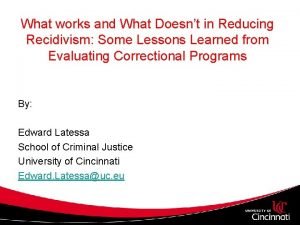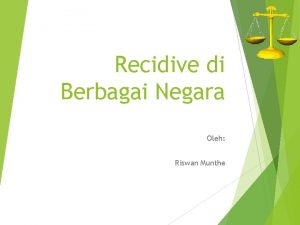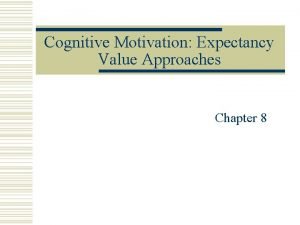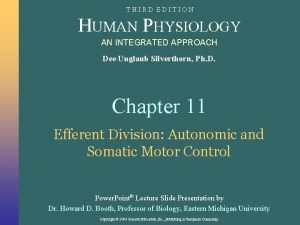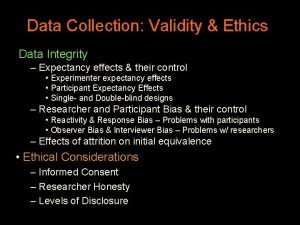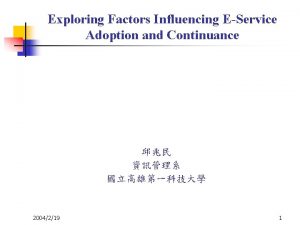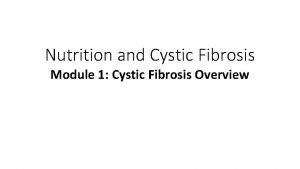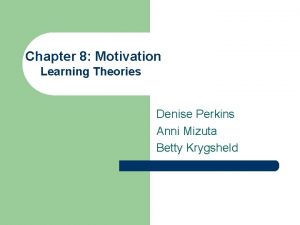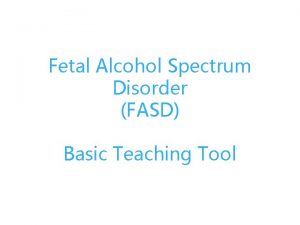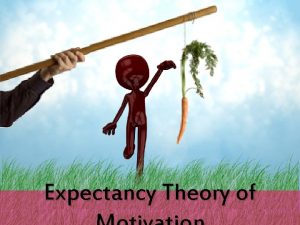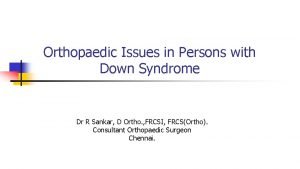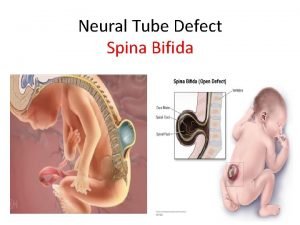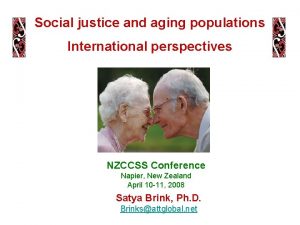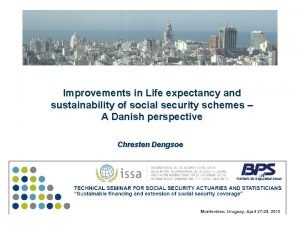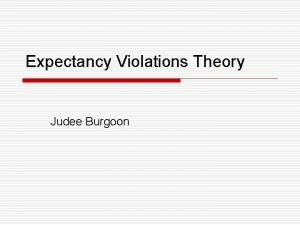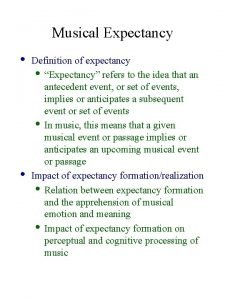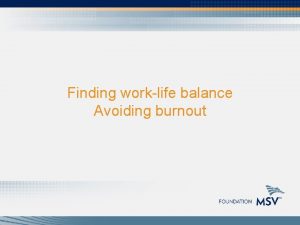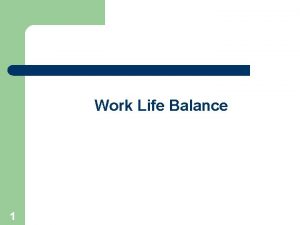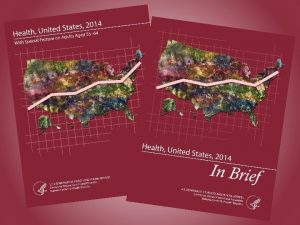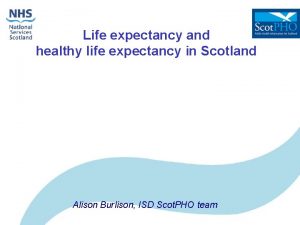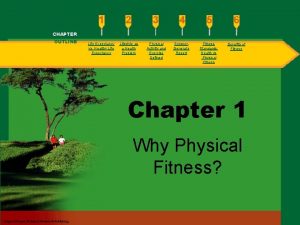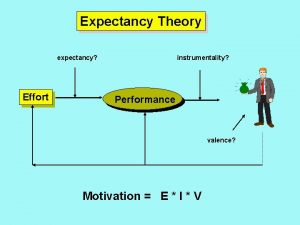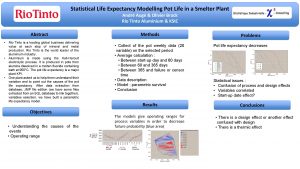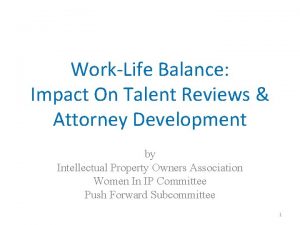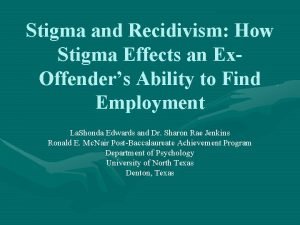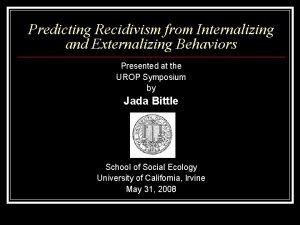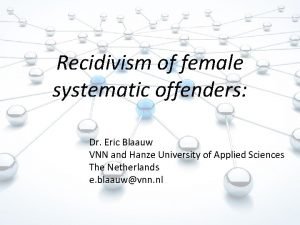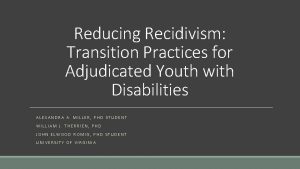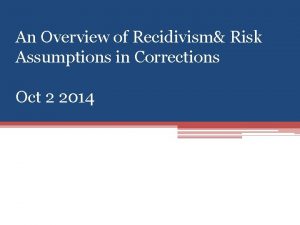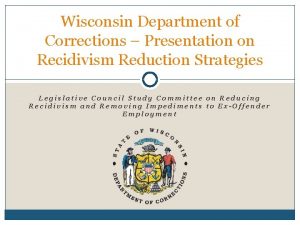Modelling the Impact of Recidivism on Worklife Expectancy



































- Slides: 35

“Modelling the Impact of Recidivism on Worklife Expectancy” Dr. Michael Nieswiadomy University of North Texas Dept. of Economics Denton, TX 76203 January 2, 2018 Allied Social Science Association Meeting NAFE Sessions Philadelphia, PA 1

Introduction • United States has the largest incarcerated population & rate in the world. – 2. 3 million inmates in prisons and jails in 2010 – 300% increase since 1980 – 1 in 100 adults are incarcerated • Risk of recidivism is high. • Bureau of Justice Statistics (2014) study of 30 states from 2005 to 2010 estimates that 55. 1% of released prisoners recidivated within 5 years • Incarcerated persons cannot participate in the labor force 2

Recidivating • Six measures of recidivating – 1) Arrest, 2) adjudication, 3) conviction, 4) incarceration, 5) imprisonment and 6) return to prison – BJS calls “Return to Prison” most common measure of recidivism • Prison defined by Bureau of Justice Statistics (BJS) as an incarceration of one year or more – This paper uses “return to prison” as recidivism measure – Return to prison may occur for reasons other than a “new crime” (e. g. , resulting from a parole violation) 3

Data • BJS comprehensive recidivism study (Durose et al. , 2014) – 412, 731 ex-prisoners in 30 states; randomly sampled 68, 597 – Cohort released from prison in 2005 and followed through 2010 • Overview – – Roughly 90% of prisoners are male About half of prison sentences are due to drug crimes Sentence lengths have increased dramatically Average time served in state prisons rose from 3. 39 years in 2000 to 4. 22 years in 2012 4

Year 2000 2001 2002 2003 2004 2005 2006 2007 2008 2009 2010 2011 2012 2013 2014 Average length of sentences served (or amount served for those still incarcerated) in state prisons All offenses Violent Nonviolent 3. 39 4. 95 1. 92 3. 49 5. 08 1. 91 3. 44 5. 10 1. 85 3. 48 5. 20 1. 83 3. 53 5. 29 1. 82 3. 58 5. 38 1. 82 3. 61 5. 52 1. 82 3. 69 5. 62 1. 84 3. 77 5. 71 1. 88 3. 89 5. 85 1. 92 4. 00 5. 94 1. 96 4. 11 6. 08 1. 99 4. 22 6. 22 2. 05 4. 32 6. 40 2. 06 4. 36 6. 51 2. 09 5

Data • Risk of recidivating declines as prisoners are out of prison longer – 30. 4% of prisoners recidivate within one year – 18. 5% of released prisoners who have remained free for one year recidivate in their second year – 11. 3% of released prisoners who have remained free for two years recidivate in their third year – 6. 4% of released prisoners who have remained free for three years recidivate in their fourth year – Finally, for those who remain free after four years, only 4. 7% recidivate in fifth year 6

BJS (2014) Table 16 Recidivisim of prisoners released in 29 states in 2005, by most serious commitment offense and time from release to first arrest that led to recidivating event Recidivism measurement and most serious commitment offense Adjudication a Violent Property Drug Public orderb Convictiona Violent Property Drug Public orderb Incarceration a Violent Property Drug Public orderb Imprisonment a Violent Property Drug Public orderb Return to prison c Violent Property Drug Public orderb 6 months 15. 2% 11. 7 18. 6 15. 4 14. 0 13. 0% 9. 8 16. 0 13. 1 12. 0 9. 8% 7. 7 12. 1 9. 4 9. 3 5. 4% 4. 2 7. 2 4. 8 4. 9 17. 6% 16. 2 21. 8 15. 4 16. 1 1 year 26. 3% 20. 6 31. 8 26. 3 24. 7 23. 0% 17. 6 27. 9 23. 0 22. 2 17. 5% 13. 9 21. 5 17. 0 17. 1 10. 0% 7. 5 13. 0 9. 4 9. 6 30. 4% 27. 5 36. 4 28. 1 27. 7 2 years 40. 7% 33. 7 46. 9 41. 7 38. 6 36. 3% 29. 5 42. 1 37. 2 34. 8 28. 8% 23. 5 33. 5 29. 0 27. 9 16. 9% 13. 2 20. 7 16. 4 16. 6 43. 3% 39. 5 49. 6 41. 8 39. 4 3 years 49. 8% 41. 7 56. 2 51. 1 48. 4 45. 2% 37. 2 51. 5 46. 1 44. 7 36. 2% 29. 8 41. 6 36. 1 36. 7 22. 0% 17. 3 26. 5 21. 5 22. 2 49. 7% 45. 4 56. 2 48. 0 46. 7 4 years 55. 9% 48. 0 62. 1 57. 1 54. 6 51. 3% 43. 4 57. 3 52. 3 50. 5 41. 3% 35. 0 46. 9 41. 2 41. 6 25. 5% 20. 3 30. 3 25. 1 25. 8 52. 9% 48. 4 59. 5 51. 2 50. 1 5 years 60. 0% 52. 6 66. 1 61. 0 58. 5 55. 4% 48. 0 61. 2 56. 3 54. 2 44. 9% 38. 9 50. 6 44. 7 28. 2% 22. 9 33. 4 27. 6 28. 2 55. 1% 50. 6 61. 8 53. 3 52. 6 Note: Prisoners were tracked for 5 years following release in 30 states. Some states were excluded from the specific measures of recidivism. See Methodology. Inmates could have been in prison for more than one offense; the most serious one is reported in this table. See appendix table 17 for standard errors. a. Based on time from release to first arrest that led to recidivating event (i. e. , adjudication, conviction, incarceration, or imprisonment) among inmates released in 29 states. b. Includes 0. 8% of cases in which the prisoner’s most serious offense was unspecified. c. Based on time from release to first arrest that led to a prison sentence or first prison admission for a technical violation without a new sentence among inmates released in 23 states. Source: Bureau of Justice Statistics, Recidivism of State Prisoners Released in 2005 data collection. 7

Assumptions • 1) Prisoners are given five-year prison sentences (BJS reports 61 -month average for males in state prisons (Rosenmerkel, Durose, and Farole, 2009)) • 2) A prisoner who remains free after 5 years will never return to prison again • 3) A person who is returned to prison for a 3 rd time (in our model; most likely they have been in prison even more than 3 times) will never be meaningfully employed again 8

Assumptions • 4) The probabilities of recidivating are not different between first and second release – Includes assumption that if a prisoner remains free for five years after a second prison term, that person will never again return to prison – True probabilities may be different after second release depending on number of previous offenses, severity of offenses, gender, or other potential factors beyond the scope of this paper because the data has not been released by the BJS 9

Assumptions • Take the cohort of the 2014 BJS study as being released for the first time • We assume our cohort consists of 100 released prisoners 10

Markov Calculations • Based on these assumptions, we begin by creating a Markov chain for the first five years after the cohort has been released. There are 5 groups of recidivists. • Group 1 returns to prison in year 1, stays there for 5 years, and will not be released until year 6, when it will repeat the process • Group 2 survives for one year, goes to prison for 5 years, and is released in year 7 • Group 3 survives for two years, goes to prison for 5 years, and is released in year 8 • Group 4 survives for three years, goes to prison for 5 years, and is released in year 9 • Group 5 survives for four years, goes to prison for 5 years, and is released in year 10 11

Markov Calculations • Following our assumptions, we have a total of 5 groups in addition to those free after 5 years who remain free forever • To construct our Markov chain, we need to calculate the conditional probabilities of remaining free after respective numbers of years 12

Markov Calculations • The probability of recidivating within one year of release is simply 30. 4%, which leaves 69. 6 of our 100 released prisoners free after one year • The cumulative probability of recidivating in the second year following release is 43. 3%, so after two years, 43. 3 of the 100 prisoners released in our cohort will be sent back to prison, leaving 56. 7 free • See Figure 1 13

Figure 1: Markov Chain for 100 Individuals Initially Released from Prison 100 Prisoners Released Year 1 0. 304 0. 696 Free (69. 6) Prison Group 1 (30. 4) =(43. 3 -30. 4)/(100 -30. 4) Year 2 Year 3 Year 4 0. 185 Prison Group 2 (12. 9) Free (56. 7) 0. 113 =(49. 7 -43. 3)/(100 -43. 3) =(69. 6 -12. 9)/(100 -30. 4) 0. 815 Prison Group 3 (6. 4) Free (50. 3) 0. 064 =(52. 9 -49. 7)/(100 -49. 7) Prison Group 4 (3. 2) Year 5 =(55. 1 -52. 9)/(100 -52. 9) =(56. 7 -6. 4)/(100 -43. 3) 0. 887 0. 936 =(50. 3 -3. 2)/(100 -49. 7) Free (47. 1) 0. 047 Prison Group 5 (2. 2) 0. 953 =(47. 1 -2. 2)/(100 -52. 9) Free Forever (44. 9) 14

Markov Calculations • Using these probabilities, we can calculate the conditional probability of recidivating in the second year, given that a released prisoner has remained free for one year – ((cumulative #recidivated after 2 nd year minus cumulative #recidivated after 1 st year), divided by cumulative #free after 1 st year) (=(43. 3 -30. 4)/(100 -30. 4) = (12. 9/69. 6) = 0. 185, or 18. 5% chance of recidivating conditioned on 1 year of freedom) 15

Markov Calculations • Using the cumulative probabilities of recidivating after year 3 (49. 7%), year 4 (52. 9%), and year 5 (55. 1%), we can calculate the conditional probabilities of recidivating after respective periods of freedom. • E. g. , ((cumulative #recidivated after 3 rd year minus cumulative #recidivated after 2 nd year), divided by cumulative #free after 2 nd year) (=(49. 7 -43. 3)/(100 -43. 3) = (6. 4/56. 7) = 0. 113, or 11. 3% chance of recidivating conditioned on 2 years of freedom) 16

Markov Calculations • Likewise, using the cumulative probabilities of remaining free after respective years, we can calculate the conditional probabilities of remaining free after a given number of years • E. g. ((cumulative #free after 2 nd year minus cumulative #free after 1 st year), divided by the number free after 1 st year) (=(69. 6 -12. 9)/(100 -30. 4) = (56. 7/69. 6) =0. 815, or 81. 5% chance of remaining free conditioned on 1 year of freedom) 17

Markov Chain • Because Groups 1 through 5 are not released at the same time, we must create a five-year chain for each group. • Figure 2 illustrates this process for Group 1 after their release at the beginning of year 6 and shows the conditional probabilities at each branch 18

Figure 2: Markov Chain for Group 1 after Prison Exit in Year 6 30. 4 Prisoners Released Year 6 0. 696 0. 304 Prison & never work Free (9. 24) (21. 16) Year 7 0. 185 =(43. 3 -30. 4)/(100 -30. 4) =(69. 6 -12. 9)/(100 -30. 4) 0. 815 Free (17. 24) Prison & never work (3. 92) Year 8 =(49. 7 -43. 3)/(100 -43. 3) 0. 113 Prison & never work (1. 95) Year 9 =(52. 9 -49. 7)/(100 -49. 7) Free (15. 29) 0. 064 Prison & never work (0. 97) Year 10 =(55. 1 -52. 9)/(100 -52. 9) =(56. 7 -6. 4)/(100 -43. 3) 0. 887 =(50. 3 -3. 2)/(100 -49. 7) 0. 936 Free (14. 32) 0. 047 Prison & never work (0. 67) 0. 953 =(47. 1 -2. 2)/(100 -52. 9) Free forever (13. 65) 19

Markov Chain • A similar process takes place for Groups 2, 3, 4 and 5. • In Tables 1 - 5, we calculate the conditional (on the number of years without recidivating) cumulative probabilities of return to prison for all offenses and the subcategories of violent, property, drug and public order offenses. 20

Table 1: Recidivism rates for return to prison by most serious offense Cumulative percent of released prisoners who recidivated within 6 months 1 year 2 years 3 years 4 years Return to prison 17. 6 30. 4 43. 3 49. 7 52. 9 Violent 16. 2 27. 5 39. 5 45. 4 48. 4 Property 21. 8 36. 4 49. 6 56. 2 59. 5 Drug 15. 4 28. 1 41. 8 48 51. 2 Public order 16. 1 27. 7 39. 4 46. 7 50. 1 Table 2: Recidivism rates for ex-prisoner who survives one year without recidivating Cumulative percent of released prisoners who recidivated within 1 year 2 years 3 years Return to prison 18. 5 27. 7 32. 3 Violent 16. 6 24. 7 28. 8 Property 20. 8 31. 1 36. 3 Drug 19. 1 27. 7 32. 1 Public order 16. 2 26. 3 31. 0 Table 3: Recidivism rates for ex-prisoner who survives two years without recidivating Cumulative percent of released prisoners who recidivated within 1 year 2 years Return to prison 11. 3 16. 9 Violent 9. 8 14. 7 Property 13. 1 19. 6 Drug 10. 7 16. 2 Public order 12. 0 17. 7 Table 4: Recidivism rates for ex-prisoner who survives three years without recidivating Cumulative percent of released prisoners who recidivated within 1 year Return to prison 6. 4 Violent 5. 5 Property 7. 5 Drug 6. 2 Public order 6. 4 5 years 55. 1 50. 6 61. 8 53. 3 52. 6 4 years 35. 5 31. 9 39. 9 35. 0 34. 4 3 years 20. 8 18. 3 24. 2 19. 8 21. 8 2 years 10. 7 9. 5 12. 8 10. 2 11. 1 Table 5: Recidivism rates for ex-prisoner who survives four years without recidivating Cumulative percent of released prisoners who recidivated within 1 year Return to prison Violent Property Drug Public order 4. 7 4. 3 5. 0 21

Calculating Yearly Probabilities of being Free • Table 6 shows the probabilities of a being “free” each year for a newly released person • Group 1, shown in Table 6, is the group of 30. 4 persons who recidivated within one year and then spent five years in jail. • At the beginning of year 6 they return to free society and by end of year 6, 30. 4% (9. 24) of these 30. 4 newly released prisoners are back in prison • By end of year 7, 43. 3% (13. 16 persons) of these 30. 4 persons will cumulatively be in prison 22

Table 6: Percentage of ex-prisoners free each year conditional on day of release Inmates 100 Year Inmates Group 1 Free Inmates Group 2 Free Group 3 Group 4 Group 5 Total Mid Point Inmates Free Free 0 0 100 0 30. 4 0 12. 9 0 6. 4 0 3. 2 0 2. 2 100. 0 1 30. 4 69. 6 30. 4 0 0 12. 9 0 6. 4 0 3. 2 0 2. 2 69. 6 84. 8 2 43. 3 56. 7 30. 4 0 12. 9 0 0 6. 4 0 3. 2 0 2. 2 56. 7 63. 2 3 49. 7 50. 3 30. 4 0 12. 9 0 6. 4 0 0 3. 2 0 2. 2 50. 3 53. 5 4 52. 9 47. 1 30. 4 0 12. 9 0 6. 4 0 3. 2 0 0 2. 2 47. 1 48. 7 5 55. 1 44. 9 30. 4 0 12. 9 0 6. 4 0 3. 2 0 2. 2 0 44. 9 46. 0 6 44. 9 9. 24 21. 16 12. 9 0 6. 4 0 3. 2 0 2. 2 0 66. 1 55. 5 7 44. 9 13. 16 17. 24 3. 92 8. 98 6. 4 0 3. 2 0 2. 2 0 71. 1 68. 6 8 44. 9 15. 11 15. 29 5. 59 7. 31 1. 95 4. 45 3. 2 0 2. 2 0 72. 0 71. 5 9 44. 9 16. 08 14. 32 6. 41 6. 49 2. 77 3. 63 0. 97 2. 23 2. 2 0 71. 6 71. 8 10 44. 9 16. 75 13. 65 6. 82 6. 08 3. 18 3. 22 1. 39 1. 81 0. 67 1. 53 71. 2 71. 4 11 44. 9 16. 75 13. 65 7. 11 5. 79 3. 39 3. 01 1. 59 1. 61 0. 95 1. 25 70. 2 70. 7 12 44. 9 16. 75 13. 65 7. 11 5. 79 3. 53 2. 87 1. 69 1. 51 1. 09 1. 11 69. 8 70. 0 13 44. 9 16. 75 13. 65 7. 11 5. 79 3. 53 2. 87 1. 76 1. 44 1. 16 1. 04 69. 7 69. 8 14 44. 9 16. 75 13. 65 7. 11 5. 79 3. 53 2. 87 1. 76 1. 44 1. 21 0. 99 69. 6 69. 7 44. 9 16. 75 13. 65 7. 11 5. 79 3. 53 2. 87 1. 76 1. 44 1. 21 0. 99 69. 6 16 44. 9 16. 75 13. 65 7. 11 5. 79 3. 53 2. 87 1. 76 1. 44 1. 21 0. 99 69. 6 17 44. 9 16. 75 13. 65 7. 11 5. 79 3. 53 2. 87 1. 76 1. 44 1. 21 0. 99 69. 6 18 44. 9 16. 75 13. 65 7. 11 5. 79 3. 53 2. 87 1. 76 1. 44 1. 21 0. 99 69. 6 19 44. 9 16. 75 13. 65 7. 11 5. 79 3. 53 2. 87 1. 76 1. 44 1. 21 0. 99 69. 6 20 44. 9 16. 75 13. 65 7. 11 5. 79 3. 53 2. 87 1. 76 1. 44 1. 21 0. 99 69. 6 21 44. 9 16. 75 13. 65 7. 11 5. 79 3. 53 2. 87 1. 76 1. 44 1. 21 0. 99 69. 6 22 44. 9 16. 75 13. 65 7. 11 5. 79 3. 53 2. 87 1. 76 1. 44 1. 21 0. 99 69. 6 23 44. 9 16. 75 13. 65 7. 11 5. 79 3. 53 2. 87 1. 76 1. 44 1. 21 0. 99 69. 6 24 44. 9 16. 75 13. 65 7. 11 5. 79 3. 53 2. 87 1. 76 1. 44 1. 21 0. 99 69. 6 25 44. 9 16. 75 13. 65 7. 11 5. 79 3. 53 2. 87 1. 76 1. 44 1. 21 0. 99 69. 6 15 23

Calculating Yearly Probabilities of being Free • Similar calculations can be made until year 10, when 16. 75 (=0. 551*30. 4) persons cumulatively will never work again • 13. 65 (=30. 4 -16. 75) persons have survived five years and thus, by assumption, will be free for the rest of their lives • Similar calculations can be made for Groups 2 -5. 24

Using the Yearly Probabilities of being Free • In the next to last column of Table 6, labeled “Total Free”, the total number of persons who are free each year are summed for those who never recidivate & each of the five groups – At the end of year 1, 69. 6 persons are free. – At the end of year 5, 44. 9 persons are free. – At the beginning of year 6, the 30. 4 persons from Group 1 are released. • some of them (21. 16) remain out of prison and join the 44. 9 persons who survived all 5 years, so that 66. 1 (44. 9 + 21. 16) persons of the original 100 persons are free at end of year 6. 25

Using the Yearly Probabilities of being Free – At the beginning of year 7, the 12. 9 persons from Group 2 are released and some of them (8. 98) are still free at the end of the year and some of the free persons (17. 24 of the 30. 4) from Group 1 are still free. • The total number of free persons equals 44. 9 plus 17. 24 plus 8. 98 which equals 71. 1 persons free – Each year some persons are added from the newly released group and some are lost from the previous groups. 26

Calculating Yearly Probabilities of being Free • After the process is completed, 69. 6 released prisoners will be free forever, and 30. 4 will never work again – Note: this 69. 6 (actually 69. 64) free persons number is not identical to the 69. 6 persons free after year 2. The numbers are nearly identical by coincidence. 27

Calculating Yearly Probabilities of being Free • Calculations are done for an arbitrary 25 future years • If we assume that persons recidivate at the mid point of the year, we can average the number of free persons between any two years to calculate the last column in Table 6, labeled “Mid Point”. This is the number of persons who were, on average, free each year. 28

Calculating Yearly Probabilities of being Free • Tables 7, 8, 9, and 10 show similar calculations for released prisoners conditional on being free 1, 2, 3, or 4 years 29

Year 0 1 2 3 4 5 6 7 8 9 10 11 12 13 14 15 16 17 18 19 20 21 22 23 24 25 Table 7: Percentage of ex-prisoners free each year conditional on one year of no recidivism Inmates 100 Group 1 Group 2 Group 3 Group 4 Jail Free Inmates Free 0 100. 00 18. 53 0. 00 9. 20 0. 00 4. 60 0. 00 3. 16 18. 53 81. 47 18. 53 0. 00 9. 20 0. 00 4. 60 0. 00 3. 16 27. 73 72. 27 18. 53 0. 00 9. 20 0. 00 4. 60 0. 00 3. 16 32. 33 67. 67 18. 53 0. 00 9. 20 0. 00 4. 60 0. 00 3. 16 35. 49 64. 51 18. 53 0. 00 9. 20 0. 00 4. 60 0. 00 3. 16 0. 00 64. 51 5. 63 12. 90 9. 20 0. 00 4. 60 0. 00 3. 16 0. 00 64. 51 8. 03 10. 51 2. 80 6. 40 4. 60 0. 00 3. 16 0. 00 64. 51 9. 21 9. 32 3. 98 5. 21 1. 40 3. 20 3. 16 0. 00 64. 51 9. 80 8. 73 4. 57 4. 63 1. 99 2. 61 0. 96 2. 20 64. 51 10. 21 8. 32 4. 86 4. 33 2. 29 2. 31 1. 37 1. 79 64. 51 10. 21 8. 32 5. 07 4. 13 2. 43 2. 17 1. 59 64. 51 10. 21 8. 32 5. 07 4. 13 2. 53 2. 06 1. 67 1. 49 64. 51 10. 21 8. 32 5. 07 4. 13 2. 53 2. 06 1. 74 1. 42 64. 51 10. 21 8. 32 5. 07 4. 13 2. 53 2. 06 1. 74 1. 42 Group 5 Inmates Free 0. 00 0. 00 0. 00 0. 00 Total Free 100. 0 81. 5 72. 3 67. 7 64. 5 77. 4 81. 4 82. 2 82. 7 81. 3 80. 7 80. 5 80. 4 80. 4 Mid Point 90. 7 76. 9 70. 0 66. 1 64. 5 71. 0 79. 4 81. 8 82. 5 82. 0 81. 0 80. 6 80. 5 80. 4 80. 4 30

Year 0 1 2 3 4 5 6 7 8 9 10 11 12 13 14 15 16 17 18 19 20 21 22 23 24 25 Table 8: Percentage of ex-prisoners free each year conditional on two years of no recidivism Inmates 100 Group 1 Group 2 Group 3 Group 4 Inmates Free Inmates Free 0 100 0. 00 11. 29 0. 00 5. 64 0. 00 3. 88 0. 00 11. 29 88. 71 11. 29 0. 00 5. 64 0. 00 3. 88 0. 00 16. 93 83. 07 11. 29 0. 00 5. 64 0. 00 3. 88 0. 00 20. 81 79. 19 11. 29 0. 00 5. 64 0. 00 3. 88 0. 00 79. 19 3. 43 7. 86 5. 64 0. 00 3. 88 0. 00 79. 19 4. 89 6. 40 1. 72 3. 93 3. 88 0. 00 79. 19 5. 61 5. 68 2. 44 3. 20 1. 18 2. 70 0. 00 79. 19 5. 97 5. 32 2. 80 2. 84 1. 68 2. 20 0. 00 79. 19 6. 22 5. 07 2. 99 2. 66 1. 93 1. 95 0. 00 79. 19 6. 22 5. 07 3. 11 2. 53 2. 05 1. 83 0. 00 0. 00 79. 19 6. 22 5. 07 3. 11 2. 53 2. 14 1. 74 0. 00 Group 5 Inmates Free 0. 00 0. 00 0. 00 0. 00 Total Free 100. 0 88. 7 83. 1 79. 2 87. 0 89. 5 90. 8 89. 5 88. 9 88. 6 88. 5 88. 5 Mid Point 94. 4 85. 9 81. 1 79. 2 83. 1 88. 3 90. 1 90. 2 89. 2 88. 7 88. 6 88. 5 88. 5 31

Year 0 1 2 3 4 5 6 7 8 9 10 11 12 13 14 15 16 17 18 19 20 21 22 23 24 25 Table 9: Percentage of ex-prisoners free each year conditional on three years of no recidivism Inmates 100 Group 1 Group 2 Group 3 Group 4 Inmates Free Inmates Free 0 100 0. 00 6. 36 0. 00 4. 37 0. 00 6. 36 93. 64 6. 36 0. 00 4. 37 0. 00 0. 00 10. 74 89. 26 6. 36 0. 00 4. 37 0. 00 0. 00 89. 26 1. 93 4. 43 4. 37 0. 00 89. 26 2. 75 3. 61 1. 33 3. 04 0. 00 89. 26 3. 16 3. 20 1. 89 2. 48 0. 00 89. 26 3. 37 3. 00 2. 17 2. 20 0. 00 89. 26 3. 51 2. 86 2. 31 2. 06 0. 00 0. 00 0. 00 89. 26 3. 51 2. 86 2. 41 1. 96 0. 00 0. 00 89. 26 3. 51 2. 86 2. 41 1. 96 0. 00 Group 5 Inmates Free 0. 00 0. 00 0. 00 0. 00 Total Free 100. 0 93. 6 89. 3 93. 7 95. 9 94. 5 94. 2 94. 1 94. 1 Mid Point 96. 8 91. 5 89. 3 91. 5 94. 8 95. 4 94. 7 94. 3 94. 1 94. 1 32

Year 0 1 2 3 4 5 6 7 8 9 10 11 12 13 14 15 16 17 18 19 20 21 22 23 24 25 Table 10: Percentage of ex-prisoners free each year conditional on four years of no recidivism Inmates 100 Group 1 Group 2 Group 3 Group 4 Inmates Free Inmates Free 0 100 0. 00 4. 67 0. 00 0. 00 4. 67 95. 33 4. 67 0. 00 0. 00 95. 33 1. 42 3. 25 0. 00 95. 33 2. 02 2. 65 0. 00 95. 33 2. 32 2. 35 0. 00 95. 33 2. 47 2. 20 0. 00 0. 00 0. 00 0. 00 0. 00 0. 00 95. 33 2. 57 2. 10 0. 00 Group 5 Inmates Free 0. 00 0. 00 0. 00 0. 00 Total Free 100. 0 95. 3 98. 6 98. 0 97. 7 97. 5 97. 4 97. 4 Mid Point 97. 7 95. 3 97. 0 98. 3 97. 8 97. 6 97. 5 97. 4 97. 4 33

Using the Yearly Probabilities of being Free • Forensic economists can use Tables 6 -10 to adjust the worklife probabilities at each age for each year • If one uses the worklife probabilities (e. g. Tucek (2015) derived from Skoog et al. , 2011) at each age, we can multiply Tucek’s (2015) probabilities by the probabilities in Tables 6 -10 to get the adjusted worklife probabilities (i. e. , multiplied by the probability of an ex-prisoner staying free). • E. g. , if an ex prisoner is injured at a point in time where they have survived three years without recidivating, then Table 9 could be used to multiply the probabilities of being free each year by the age appropriate worklife probabilities. 34

Conclusion • This paper has shown how to model the probability of an ex-prisoner being free in future years conditional on how many years the person has survived without recidivating • This method can be modified if data/statistics are available for additional factors, such as gender or age at the time of release. 35
 Workshop worklife balance
Workshop worklife balance What works and doesn't in reducing recidivism download
What works and doesn't in reducing recidivism download Recidive
Recidive Probing incorrect answers with low expectancy students
Probing incorrect answers with low expectancy students Progeria life expectancy
Progeria life expectancy Puritan life expectancy
Puritan life expectancy Field theory psychology
Field theory psychology Expectancy theory
Expectancy theory Life expectancy world bank
Life expectancy world bank Rohhad life expectancy
Rohhad life expectancy Definition of motivation in organisational behaviour
Definition of motivation in organisational behaviour Page life expectancy
Page life expectancy Experimenter expectancy effects
Experimenter expectancy effects The expectancy model is developed by -
The expectancy model is developed by - Panda animal pinch pots
Panda animal pinch pots Cystic fibrosis life expectancy
Cystic fibrosis life expectancy What are the key tenets of expectancy theory?
What are the key tenets of expectancy theory? Social cognitive theory motivation
Social cognitive theory motivation Island with longest life expectancy
Island with longest life expectancy Deuteranomaly
Deuteranomaly Signal detection theory example
Signal detection theory example Fetal alcohol syndrome life expectancy
Fetal alcohol syndrome life expectancy Life expectancy evolution
Life expectancy evolution Expectancy theory
Expectancy theory Down syndrome life expectancy
Down syndrome life expectancy Neural tube defect
Neural tube defect Health life expectancy
Health life expectancy Law of reinforcement
Law of reinforcement Life expectancy definiton
Life expectancy definiton Life expectancy evolution
Life expectancy evolution Life expectancy of sickle cell patients
Life expectancy of sickle cell patients Liisi voksepp
Liisi voksepp Annual loss expectancy
Annual loss expectancy Communicator reward valence
Communicator reward valence Demonstrating value and respect for low expectancy students
Demonstrating value and respect for low expectancy students Trisomy 13
Trisomy 13

